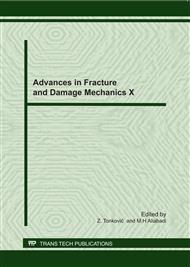p.553
p.557
p.561
p.565
p.569
p.573
p.577
p.581
p.585
The Influence of Short Glass and Polypropylene Fibers on First Crack Formation and Toughness of Cement Based Composites after their Exposure to Fire Conditions
Abstract:
The influence of glass and polypropylene short fiber addition on fracture response of cement based composites after their exposure to high temperatures up to 900°C and for time intervals up to 2 hours was investigated during this study. These conditions simulate adequately closed those of a common real fire exposure. Measurements of their bending and compressive strength and also of ultrasonic wave propagation before and after their burning were carried out. Three distinct response zones are appeared that arise mainly by the incoming chemo-physical changes of constituents due to the attainment of remarked temperature levels. These changes involve the evaporation of physically bounded water in pores and paste in the region of 100°C, the de-hydration of calcium hydroxide of cement paste in the region of 400°C and the decomposition of calcium carbonate of limestone aggregates in the region of 900°C. The fiber addition at common level volume percentage of about 0.3 %, improve only slightly their fracture features –as first crack formation, energy absorption, even their strength– up to 300 - 400°C after of which this addition appears to have opposite effects. The essential changes seem to concern the improved cohesive features of cement based composites and the desired benefits arise mainly by ensuring better conditions for their durability and the restriction of their fragmentation and brittleness leading to a tougher future response.
Info:
Periodical:
Pages:
569-572
Citation:
Online since:
September 2011
Price:
Сopyright:
© 2012 Trans Tech Publications Ltd. All Rights Reserved
Share:
Citation:


